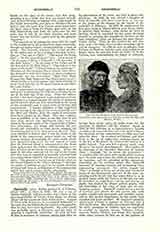

Signorelli, LUCA, Italian painter, b. at Cortona, about 1441; d. there in 1523. He was a son of Egidio Signorelli, and his mother was a sister of the great-grandfather of Vasari, from whom we obtain almost all the important facts of his career. A pupil of Piero della Francesca, he was largely influenced in his early days by Pollaiuolo, by whom it seems possible that he may have been instructed. His early youth was probably spent in Florence, and his style of painting is essentially Florentine. In 1479 we hear of him in residence at Cortona, taking high office in the government of the town, and held in great consideration. In 1488, he was elected a burgher of Citta di Castello, and three years later he was one of the judges of the designs for the facade of the cathedral at Florence. In 1497, he commenced his first great work at Monte Oliveto near Siena, where he painted eight frescoes; from thence he went to Orvieto, where he remained for five years, devoting himself to painting his magnificent frescoes of the Last Judgment, which are perhaps his most characteristic works. There he also painted his own portrait, with a few bold, clever strokes revealing a great deal of character. In 1508 he went as delegate from Cortona to Florence, and the same year passed on to Rome, where he executed work for Julius II in the Vatican, now unfortunately no longer in existence, having been swept away to make room for the paintings of Raphael and his scholars. Again in 1512 he left Cortona as a representative, bearing an address of congratulation, and went again to Rome, but obtained no new commissions, as other men had taken his place. He returned to Cortona, and there lived to the age of eighty-two, working almost up to the day of his death; he received the honor of a public funeral. Few men left a greater mark upon the art of the period than Signorelli. He is spoken of by Berenson as the “grandest illustrator of modern times”, although “by no means the pleasantest”. In another place the same critic speaks of his mastery over the nude and action, the depth of refinement of his emotions, and the splendor of his conception, remarking on the extreme power that Signorelli possessed of creating emotion and triumphing when representing movement. Art critics regard his “Pan” at Berlin as being one of the most wonderful works of the Renaissance and one of the most fascinating works of art that has come down to us in modern times; while his frescoes at Orvieto can only be described as magnificent, austere and strange no doubt, but marked by almost perfect genius, with full knowledge of the sense of form, and an awe-inspiring majesty. Signorelli stands out as a master of anatomy and almost the only person who could render complicated movement and crowded action, and in this special department he has rarely been equalled and never excelled. He cannot be properly appreciated without a journey to Cortona, and a visit to Orvieto. His works are scattered through all the little townships of Umbria, and can especially be studied in Loretto, Arezzo, Volterra, Foiano, Arcevia, Monte Oliveto, and Borgo San Sepolcro, while other pictures by him are in the galleries of Florence, London, Liverpool, Berlin, Milan, Paris, Perugia, and Rome.
GEORGE CHARLES WILLIAMSON

